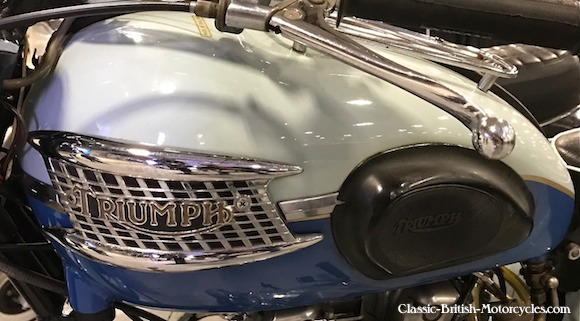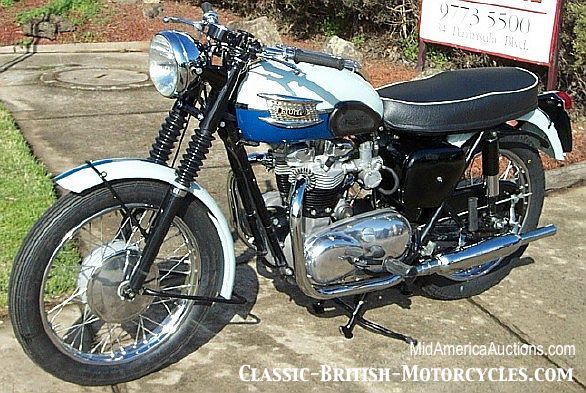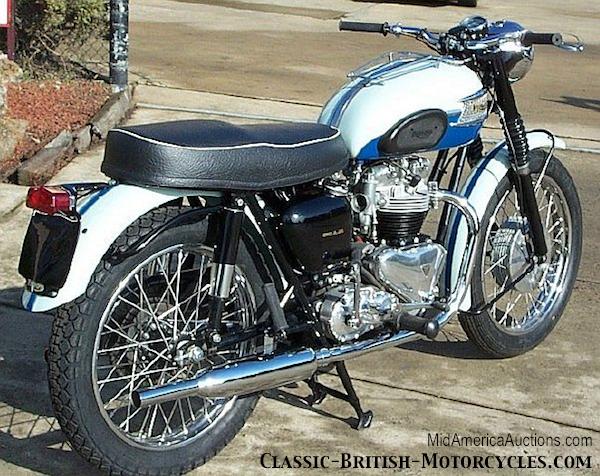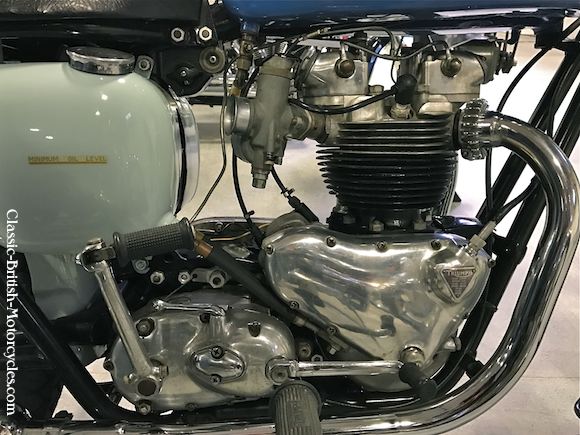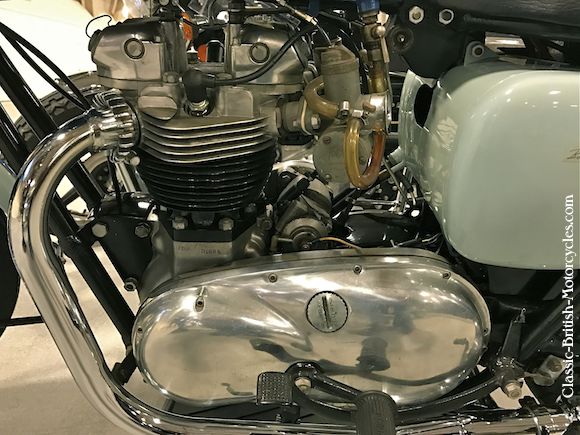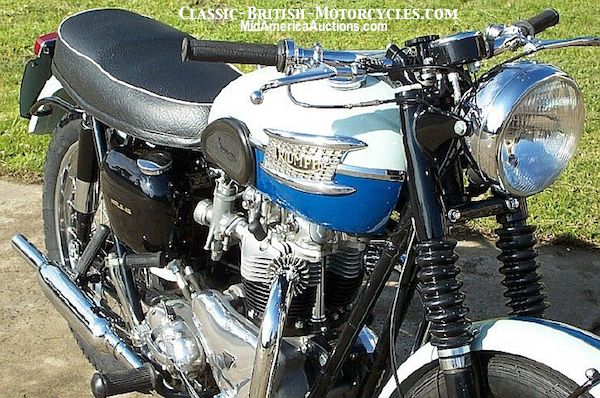ABOVE: 1960 Triumph Bonneville TR7/A Roadster w/down pipes.
MODEL DESIGNATIONS
The 1960 Triumph Bonneville was designated TR7 by Triumph Motorcycles in the US, to differentiate it from all the unsold 1959 T120s still in inventory (even though engine numbers still had the T120 prefix), and the TR6 Trophy-Bird, the Bonneville came as the TR7/A roadster and TR7/B off-road/desert racer.
NEW LOOK
Despite the Bonneville’s success, having been rushed to market, it suffered from some grave deficiencies. First off, the Tangerine and Gray color scheme was considered to loud for most buyers. Secondly, the staid look of the sheetmetal (a headlight and fully valanced fenders) turned off the most Buyers in the US, who were used to riding in nice weather. Third, the frame, a carryover from the 1954 T110 and overtaxed with the extra power, was a wobbly mess, due to poor support of the swing arm pivot. Triumph knew they had a major hit on their hands, if they could just fix the problems quickly for the 1960 Triumph Bonneville. And fix them they did. Well…sort of.
ABOVE: 1960 Triumph Bonneville TR7/A. Note open carb, no filter.
NEW COLORS
They addressed the color, replacing it with a nice Pearl Grey and Azure Blue paint scheme. They stripped the touring-style T110 bodywork off and replaced it with the minimalist hardware from the Triumph TR6 Trophy line (small tank & fenders and a detachable headlight). Starting with the 1960 Triumph Bonneville, from now on Triumph Bonneville would be the ‘sister bike’ to the Triumph TR6.
NEW DUPLEX FRAME
They tackled the handling issues with a whole new frame, called a “duplex frame” because of its twin front downtubes, replacing the single downtube in the 1959 frame. While it solved the weakness in the swing arm mounting, and cleared up the ‘wobble and weave’ that earned the old frame the nickname “Whip Iron”, the new duplex frame had problems of its own.
ENGINE
Internally, the 1960 Triumph Bonneville engine differed little from 1959. The big change however, was the switch from a DC Dynamo to a more modern AC Alternator to power the lights. The Lucas RM15 6-volt alternator was mounted on the left end of the crankshaft inside the primary case. A new outer cover bulged out, giving the needed clearance, which necessitated a new exhaust (1-1/2″ diameter as before), although they look identical to the naked eye. In the US, the 1960 Triumph Bonneville TR7/B Scrambler had high pipes (one on each side) with heat shields and shorty silencers. The TR7/A Roadster had a tachometer driven off the exhaust cam, on the timing side. Primary gearing was lowered slightly with a reduction in the size of the engine sprocket from 24 to 22 teeth.
CARBS
Initially, the same Amal Monobloc carburetors used in 1959 were, but with the remote float bowl relocated further forward and rubber-mounted to fight vibration-induced fuel frothing. A new float bowl (Type 14/624) replaced the old (Type 14/617), but the problem persisted. Finally, starting with engine #D5975, standard Amal Monoblocs with integral float bowls were fitted.
ELECTRICS
Magneto ignition would remain with the Triumph Bonneville throughout its pre-unit life (1959-1962). For the 1960 Triumph Bonneville, UK and export machines received the Lucas K2F auto-advance Magneto which gave a 30-degree spark advance variance. US models retained the same K2FC unit as used in 1959. The switch from Dynamo to Alternator required a rectifier to convert AC to DC. The battery remained the same as before. Gauges were as before, but not mounted in a nacelle any more. US street models (TR7/A) mounted a Smiths Chronometric 120mph speedo and a matching tachometer side-by-side. Off-road models (TR7/B) had only a speedo. The headlight switch was relocated under the nose of the seat to the right.
DUPLEX DETAILS
Of course, the big news for the 1960 Triumph Bonneville was the new duplex frame, designed to eliminate the handling problems of earlier Triumphs. Instantly recognizable by its two front downtubes running from the steering head down under, and cradling the engine, hence the name “duplex”. It certainly strengthened the swing arm pivot-area (the source of the ill-handling prior), but it also offered a steeper steering head angle, 67 degrees from 64-1/2 degrees for the 1959 (this shorted the wheelbase from 55-1/4″ to 54-1/2″). This was done to improve steering and stability and it worked. The new 1960 Triumph Bonneville handled great!
Like previous designs, the duplex frame used lugged and brazed construction and a detachable rear subframe. The problem with the duplex frame was that it had only a single backbone running under the tank to the steering head. This proved to be weak when subjected to the endless pounding of US desert racing, which lead to many cracked steering heads. Starting with engine #D1563 the frame was revised with the addition of a lower frame rail bracing the backbone and the steering head. Earlier bikes were retrofitted by the dealer.
RUNNING GEAR
The front forks were carried over from the 1959 Triumph Bonneville, but greatly improved with the addition of two-way damping. The fork sliders were slightly longer to compensate for the move from a 19″ front wheel to 18″. With the deletion of the unloved headlight nacelle, new upper fork shrouds and headlight brackets, finished in black, were added. The top yoke (triple clamp) was swapped for a Triumph TR6 unit, and the ignition cut-out (kill switch) was moved to the right of the damper knob. Most of the 1960 Triumph Bonneville 650s sold in the US were ordered with the optional (and more expensive) QD (Quickly Detachable) rear wheel.
BODYWORK
The other welcome news for the 1960 Triumph Bonneville was the styling. Gone was the headlight nacelle, full fenders and flamboyant Tangerine paintjob. In their place was a a QD headlight, slim fenders and a nice Azure Blue and Pearl Grey paint combo. The gray fenders featured blue stripes lined in gold pinstripes running their length. The top of the tank was blue, the bottom grey, separated by gold pinstripes as before. A thicker, more comfortable touring seat was selected for the Bonneville, and was finished in black vinyl with white piping. The new look was spot on. From here on, the Triumph Bonneville would be styled like the TR6.
BELOW: 1960 Triumph Bonneville TR7/A w/Euro-style low bars.
1960 Triumph Bonneville SPECIFICATIONS
|
Bonneville TR7/A Bonneville TR7/B Engine type Displacement Bore & Stroke Compression Carburetor Ignition Engine output Primary drive Primary sprockets Clutch Gearbox 1st, bottom 2nd 3rd 4th, top Final drive Final drive sprockets Frame Type Suspension, front Suspension, rear Brake, front Brake, rear Tire, front Tire, rear Wheelbase Seat Height Ground Clearance Fuel capacity Dry weight |
Roadster (low pipes) Scrambler (high pipes) Air-cooled OHV vertical twin, non-unit 649cc / 40.0 ci 71mm X 82mm / 2.79″ X 3.23″ 8.5:1 2- Amal Monobloc 1-1/6″ Lucas magneto 46 bhp @ 6500 rpm 1/2″ X .335″ X 5/16″ chain, 70 links 22T X 43T Multi-plate, wet 4-speed constant mesh, right foot shift 11.9:1 8.25:1 5.81:1 4.88:1 5/8″ X .400″ X 3/8″ chain, 101 links 18T X 43T Brazed lug, rigid Telescopic fork, hydraulic damping Swing arm, 2 Girling dampers 8″ SLS drum 7″ SLS drum 3.25″ X 18″ Dunlop 3.50″ X 18″ Dunlop 54.5″ / 140 cm 30.5″ / 77 cm 5″ / 12.7 cm 3 Imp gal (US); 4 Imp gal (UK & export) 393 lbs / 178 kg |


